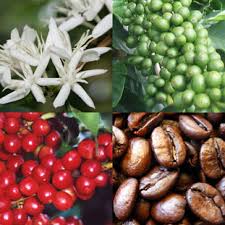 The earliest origins of coffee are from Ethiopia. There is not an exact history about how people started roasting and drinking “coffee” only legends and myths. However, it was originally viewed as a food. The Ethiopians chewed the plant for it’s obvious stimulant properties, and also ate the fruit raw (the pulp is sweet and caffeinated.)
The earliest origins of coffee are from Ethiopia. There is not an exact history about how people started roasting and drinking “coffee” only legends and myths. However, it was originally viewed as a food. The Ethiopians chewed the plant for it’s obvious stimulant properties, and also ate the fruit raw (the pulp is sweet and caffeinated.)
They also pounded coffee cherries and mixed it with animal fat to mold into pellets. There are records that show the cherries were also used to make wine.
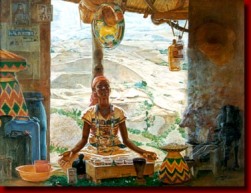 The earliest use of coffee as a hot beverage entailed roasting the entire hull over an open fire and then mixing with boiling water for 30 minutes until a yellowish liquid came through.
The earliest use of coffee as a hot beverage entailed roasting the entire hull over an open fire and then mixing with boiling water for 30 minutes until a yellowish liquid came through.
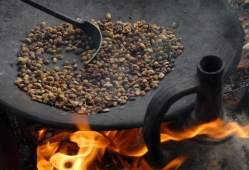 The drink stayed a green drink until aprx. the 13 century when they began to first dry the beans. With more experimentation, the process was adapted further, and the practice of roasting formed.
The drink stayed a green drink until aprx. the 13 century when they began to first dry the beans. With more experimentation, the process was adapted further, and the practice of roasting formed.
 Once coffee became the dried, roasted, and brewed drink we know it as today, it was mainly used for “medicinal” purposes and in religious practices. However, once it became increasingly popular, and a demand grew, the original coffee houses started opening.
Once coffee became the dried, roasted, and brewed drink we know it as today, it was mainly used for “medicinal” purposes and in religious practices. However, once it became increasingly popular, and a demand grew, the original coffee houses started opening.
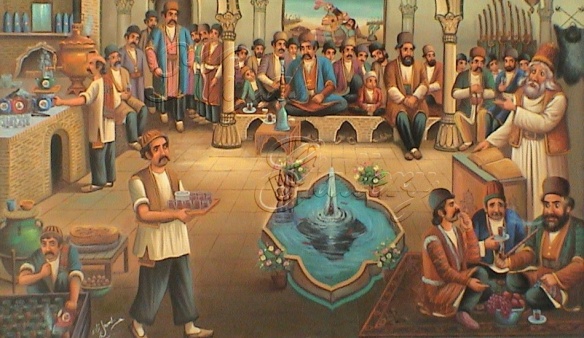 Persian cities became known for having stylish and elaborate coffee houses. They were reputed for serving coffee quickly and efficiently. They became famous social spots, where people gathered not just for coffee but also music, talking, and even dancing.
Persian cities became known for having stylish and elaborate coffee houses. They were reputed for serving coffee quickly and efficiently. They became famous social spots, where people gathered not just for coffee but also music, talking, and even dancing.
 Gradually the coffee house trend made its way to Turkey. The Turkish however drank just as much coffee in home as at coffee houses. This increased popularity and demand. By the 1600’s news spread and export and trade began throughout the Middle East; supplying Venetians and Europeans with beans.
Gradually the coffee house trend made its way to Turkey. The Turkish however drank just as much coffee in home as at coffee houses. This increased popularity and demand. By the 1600’s news spread and export and trade began throughout the Middle East; supplying Venetians and Europeans with beans.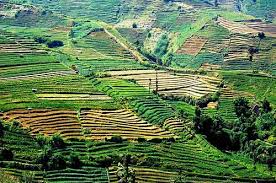
Eventually the coffee tree made its ways to the East Indian Dutch colony of Java. From there plantations started sprouting in neighboring colonies; Sumatra, Timor, Bali, and Celebes.
 Through the efforts of the British East India Company, coffee became popular in England as well. Oxford’s Queen’s Lane Coffee House, established in 1654, is still in existence today. Coffee was introduced in France in 1657, and in Austria and Poland after the 1683 Battle of Vienna, when coffee was captured from supplies of the defeated Turks.
Through the efforts of the British East India Company, coffee became popular in England as well. Oxford’s Queen’s Lane Coffee House, established in 1654, is still in existence today. Coffee was introduced in France in 1657, and in Austria and Poland after the 1683 Battle of Vienna, when coffee was captured from supplies of the defeated Turks.
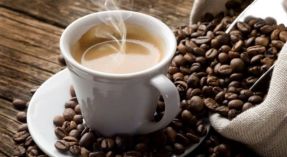
A beverage as black as ink,
useful against numerous illnesses, particularly those of the stomach. It’s consumers take it in the morning, quite frankly, in a porcelain cup that is passed around and from which each one drinks a cupful. It is composed of water and the fruit from a bush called bunnu.
— Léonard Rauwolf, Reise in die Morgenländer (in German)


Picturesque and a joy to learn more about liquid silk and learned a few things I did not know! Cheers!
LikeLiked by 1 person
Liquid silk, a great reference. 🙂
LikeLiked by 1 person
Thannnnkyyaaaaa ; )
LikeLiked by 1 person
Pingback: A Brief Origin of Coffee – worldtraveller70
Hi there! I’ve nominated your blog for the Versatile Blogger Award. For instructions, visit: https://eths.wordpress.com/wp-admin/post.php?post=8617&action=edit
LikeLike
I’m so pleased to have such great background information. I will be prompt with tomorrow’s medication.
LikeLiked by 2 people
The best medicine indeed! 🙂
LikeLike
An interesting read! Love the way you put this together. Thank you!
LikeLiked by 1 person
🙂
LikeLiked by 1 person
Edward Lloyd of London, owned a coffee house in 1688 on Tower Street. His coffee house was used as a meeting place for ship owners and the like, to discuss shipping and insure cargo, So began Lloyd’s of London, all over a cup of coffee.
LikeLiked by 2 people
I love it! It’s so cool to learn history that connects dots to our every day familiarities.
LikeLike
Great history lesson. You always make history fun. Great post.
LikeLike
You write very eloquently and I love coffee myself! This was a great read 🙂
LikeLiked by 1 person
Thank you 🙂 Coffee is a magnificent plant!
LikeLiked by 1 person
Interesting. Thank you. I never used to drink coffee that much until I discover the flat white…but I still prefer tea! ☕️😉
LikeLiked by 2 people
Flat white is my go to drink 🙂 I do love tea as well though! 🙂
LikeLike
Fascinating! Although I’m not a coffee drinker, I really enjoyed your brief, well-illustrated account of its origin.
LikeLiked by 2 people
Thank you. For me seeing things visually helps me get a better understanding. I also really like tea. 🙂
LikeLike
Pingback: A Brief Origin of Coffee - 4 My Dollar
A great read, even though I’m probably the only person in the world who doesn’t like coffee, lol.
LikeLiked by 1 person
I’ve had other people mention that they don’t like coffee, so it’s not that uncommon. I do also love a tea tremendously. 🙂
LikeLike
Interestingly, I visited a coffee museum just last week 😊
LikeLiked by 1 person
Fun. 🙂
LikeLiked by 1 person
Really interesting! I never knew any of that.
LikeLiked by 1 person
The Coffea plant is really amazing. 🙂
LikeLiked by 1 person
Loved it!
LikeLiked by 1 person
🙂
LikeLike
Wow!! That’s interesting. I love how you wrote it!
LikeLiked by 1 person
Thank you 🙂
LikeLiked by 1 person
A footnote: The reason coffee is so much more popular in this country than tea is that just prior to the Revolution,. when things between the Colonies and England were tense, there was a ban on tea and coffee became the drink of choice. It still is! Fun facts.Thanks, Abbie.
LikeLiked by 1 person
SO many people ask that question! 🙂
LikeLike
Reblogged this on John's Notes and commented:
I liked this concise history of coffee. I enjoy a couple of cups of coffee each morning brewed from fresh ground roasted beans.
LikeLike
Hi Abbie, I am a bit of a history nut (pretty much any history) and always interested in learning new things. My father traveled the world for his job and learned to love and appreciate tea. So, in the evenings my family drank tea and while I always loved the different types and flavors, and I still drink it. Coffee wasn’t an acquired taste until I started working as a social work home visitor. People were always offering me coffee, so I drank it to be polite. It is probably almost amazing I did acquire the taste given how awful some of the stuff I drank was! Of course, now I have my favorites in various incarnations. My daughter has tried to teach me the nuances of beans and levels of roasting, the different between strongly flavored and burnt beans…not sure I get them all, but I do know what I like! Thanks for the information…time to go get my third cup. Joanne
LikeLiked by 1 person
It took a while for me to discover the ways I like it as well, and my tastes have definitely adapted over time as well.
LikeLiked by 1 person
That one cup in the morning of flat white is like a warm hello to my whole body!
LikeLiked by 1 person
Such a good feeling, enjoying that first cup!
LikeLiked by 1 person
Great overview! Thanks for sharing 🙂
LikeLiked by 1 person
What an interesting post Abbie.
LikeLiked by 1 person
Glad to hear it. 🙂
LikeLiked by 1 person
So interesting, great post Abbie!
LikeLiked by 1 person
Thank you 🙂
LikeLiked by 1 person
Reblogged this on wwwpalfitness.
LikeLiked by 1 person
Every day’s a school day 🙂
I’m currently reading a book set in the late 1800s in Iceland and I was surprised to read about the poorer Icelander’s asking each other if they had any coffee left. Apparently I had no idea we had it in Europe so early. This piece puts that into better perspective, so thank you 🙂
LikeLiked by 1 person
It sure is 😀 I love learning new interesting thing!
LikeLike
I can only imagine the faces on people when they discovered the aroma of fresh roasted beans 🙂
LikeLiked by 1 person
A magic moment 🙂
LikeLiked by 1 person
For sure! 😄
LikeLiked by 1 person
Hi Abbie!
I think we can all agree that coffee rocks. I’ve had a love affair with coffee since long before I was supposed to be drinking it.
I’ve nominated you for the 3 Day 3 Quote Challenge, btw. I don’t know if you like to participate in stuff like that and feel free to opt out, but if you want to play: http://bubblesandbeebots.com/2016/02/17/3-day-3-quote-challenge-day-3/
LikeLiked by 1 person
i was only recently asking this question without looking for an answer…those happy times where wikipee and poogle are decayed and not a coffee bean farmer in sight…..how serendipity is lovely brewed
LikeLiked by 1 person
That makes me happy 🙂
LikeLike
Pingback: 3 Quotes, 3 Days Challenge: Day 1, Daily Routine – Creative Writing For Me
Interesting history. Very good presentation. BUT I am still a loyal tea drinker…
LikeLiked by 1 person
Thank you! I love Tea as well 😀
LikeLike
Pingback: A to Z Doobsters (formerly of Mindful Digressions) – In the Zone
What would we do without coffee? 🙂 Funny thing about your post: I finished high school in Ethiopia, and I just now realize that coffee was not a big deal back there and then. Strange.
What would your favourite coffee be? At home, we have colombian. Mainly Quindío.
LikeLiked by 1 person
Favorite coffee bean, or favorite coffee drink? I like my Stumptown Hair Bender and I love a flat white. 🙂
LikeLiked by 1 person
Hair bender? Oh. That sounds like it can keep you awake for a week. 😉
LikeLiked by 1 person
😀
LikeLiked by 1 person
I love history and origin stories.
Enjoyed reading this and the photos you used to accompany the story.
When I finally make a trip to England, I will stop into the place you mentioned 🙂
LikeLiked by 1 person
It would be pretty awesome I think. 🙂
LikeLiked by 1 person
My friend and I used to refer to our afternoon coffee at the office as ‘the precious.’ Great history of the bean. I’d also love to read a history of coffee through the 20th century. I bet all of the new marketing and commercialization would make it an interesting read. As well and new ways to brew…like the aeropress, chemex, etc.
LikeLiked by 1 person
It has definitely never slowed down economically, there are always new things being invented and new ways to enjoy the wonderful bean being explored. Enthusiast always have something new to learn, it’s all so very interesting. 🙂
LikeLiked by 1 person
Agreed and I’m sure there will be new methods to make our most advanced methods out of date. So a related question: what temp of water do you brew at? I’ve been doing 175 degrees F, which is what the aeropress manual recommended but I got on a thread yesterday and the author suggested 195-205. I tried that temp out today and…the results were better than the 175.
LikeLiked by 1 person
For the Aeropress, I haven’t tested it out a whole lot yet. I’ve had it at between aprx. 190-200 and it’s been good. I may try going to 205 and see if it makes a difference. I prefer to go as hot as possible without the risk of ruining the flavor.
LikeLiked by 1 person
The 200-205 seems optimal for aerorpress. I go lower for is good for the French press. I’ve noticedb
LikeLike
Lol sorry I hit send before I finished …I meant to say I like to go a little lower on the French press. 190 or even a little below that seems best for me. I’ve gone just sub-boil into the press and I’ve burned it a little. Hey we always want to be on quality control when it comes to temperature management 🙂
…I meant to say I like to go a little lower on the French press. 190 or even a little below that seems best for me. I’ve gone just sub-boil into the press and I’ve burned it a little. Hey we always want to be on quality control when it comes to temperature management 🙂
LikeLiked by 1 person
I think I’ll try it at 205 🙂
LikeLiked by 1 person